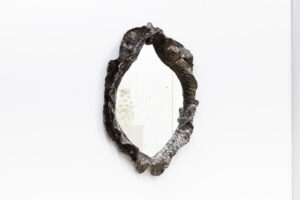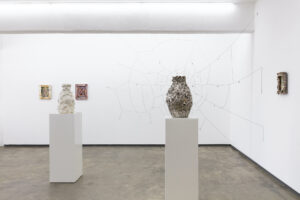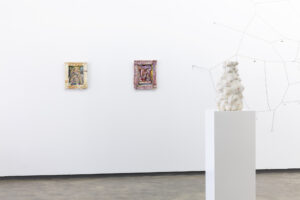
08.11.2023
On the occasion of his last individual exhibition at Saenger Galeria, Christian Barragán interviews Alejandro García Contreras about the processes of Vibrations of an Imperfect Cosmic Web and his work in general.

The creative work of Alejandro Garcia Contreras is characterized by experimentation and dialogue between different materials and technical resources, making his work a mix between different media such as painting, sculpting, photography, video and graphics. Through his artistic projects, he explores themes inspired by contemporary popular culture, folklore, myth, occultism and religion. Having grown up in Chiapas, in southeastern Mexico, the artist was educated closely with nature and esotericism, such that at an early age he experimented with occultism and magic. The work of Alejandro Garcia Contreras explores the unconscious, projecting codes and other elements that inhabit it. Similarly, the artist remembers that art used to create magical objects that represented life and death. In addition to this, eroticism and femininity are also issues present in his work, which tend to materialize mainly in sculpture and painting.
Simultaneously, through its nods to the Mesopotamian goddess Ishtar, the explicit is interspersed with the familiar and functional. In this way, viewers are invited to question their own relationship with the feminine, domesticity and eroticism through taboo images. Hidden penis handles and breast-shaped vases pay homage to the furniture collection of Russian Empress Catherine the Great, as well as the surreal forms of Hans Bellmer. Alejandro Garcia Contreras’ research on the history of eroticism in Japanese and Mesopotamian culture is fundamental for this artist’s reflection on the long and complicated relationship of our society with sexuality.
Christian Barragan: We have commented on other occasions about your training and transition through ceramics, which began while you were a student at the La Esmeralda school more than twenty years ago. What have you found in this field that keeps you there?
Alejandro Garcia Contreras: One of the things I have found is the possibility of continuing to develop different ways of approaching the same medium, and although painting or sculpting can also offer this, ceramics brought me closer to that potential to dimension how the same material – in this case, clay― can be developed in multiple ways. I started working precisely at La Esmeralda, and the first projects and pieces I made were mostly figures. I think the reason why I was interested in ceramic sculpting was because of the permanence of the material and because I genuinely always had an obsession with action figures, with toys, and ceramics allowed me to think about this possibility of generating permanent objects. Furthermore, my interests have changed over the course of my exploration of ceramics: It is no longer just clay figurines that represent characters, but suddenly, as has happened with the most recent projects—for example, with the vases—more complex narratives become present where the material and the medium have allowed me to also involve other disciplines of my artistic education. Within ceramics itself, I found a way to approach sculpting, engraving, drawing and painting. I think this has been one of the fundamental reasons why I have not been able, nor am I interested, to get rid of ceramics in my practice.
CB: And yet, painting and engraving have also been present since the beginning of your exercise…
AGC: Yes, but without the intention of it being a reason for direct exploration or, say, a research thesis. More was generated gradually and naturally, without the need to force any type of discipline or dynamic that fit within the production of ceramics, but rather it occurred in such an organic way that the exploration itself led me to these resources and mediums to be able to present my vision of the pictorial, the graphic and the sculptural.

CB: For your individual exhibition in the Project Room of Saenger Galeria, this fall, ―Vibrations of an Imperfect Cosmic Web― you have put together a selection of works that includes ceramics both in sculpture ―the vases― and in painting ―with reliefs along the edge of the canvas as frames. But there is also work that brings together both disciplines from the same medium, such as the small-format plate ―Universa (2021)― that commemorates Courbet’s The Origin of the World (1886) and which is the center of your exhibition. Can you elaborate on this?
AGC: Of course, it is because I understand ceramics as a hybrid space where I am interested in developing it outside of traditional or standardized concepts that have almost always delimited it towards the utilitarian; but I am also interested in working from the utilitarian to make an exploration that is more playful and more aesthetic. Even motivating or proposing the possibility that these objects lose certain functionality, although due to their complexity they sometimes retain part of it. That is to say, going back to vases, the vase can still hold water or it can be used as a flower vase and also be a grain container, but now, it is also about what it symbolizes and means. For me, at this moment, this exploration focuses on what these objects become, which are no longer an aesthetic excuse nor a utilitarian resource, but rather they carry and contain a series of experiences, anecdotes and perceptions of what would be vital and what would also be failure. I understand failure as a possibility of permanence, as a reminder of the qualities of ceramics. And I also assume it as these annotations or notes that from my point of view generate my true interest in the creation of these objects. I have never thought that my practice is merely an aesthetic exploration, much less have I thought that my practice is the search for a thesis, for a sculptural projection. I think that clarity happens when these objects are finally built and I manage to absorb them from that timeless dimension that is exclusively mental. By seeing them already converted into something, I can understand a little better why I had the need to make them and why I was also looking for that solution; although, as I say, I never have a clear idea of how these objects are going to be finalized.

CB: In this work, Universa (2021), several of the issues that are of greatest interest to you also come together: eroticism, the universe, manga, humor and mystery, through the same point from which a spider web built on-site extends and retracts (in turn, another of your favorite images). A couple of years ago, you said about this work: “The big bang would be an orgasm, or a furnace that calcined all these elements that created the universe.”
AGC: Universa has to do with the concept of existence: life, memory, or whatever the hell it means, because beyond being a reference to personal interests ―eroticism, manga or the universe, as you very well said―, I think that it is an attempt to understand creation and its consequences: existence itself. It is from there that this work arises, the creation of the universe as a metaphor for a great orgasm. Also, in the medium of ceramics, there is an analogy linked to the Big Bang, where the kiln burns the materials that are used under the pressure of fire to give rise to something new. All of this led me to link it with Courbet’s work, The Origin of the World. But I would think that what this particular piece of mine tries to do, from my condition as a male, is to understand and convey where I come from, where we come from. In the end, there it is: a cosmic force, a creating entity, perhaps a female one. In Universa, there is a real interest in approaching and understanding the feminine from what could be the origin of the universe.
23.03.2024
Opinion Cartografía sentimental de la brutalización en curso Argentina, Latinoamérica
Duen Sacchi
22.03.2024
Marginalia
(Español) La Revuelta
08.03.2024
Opinion
María Galindo
Comments
There are no coments available.